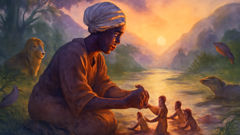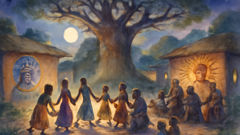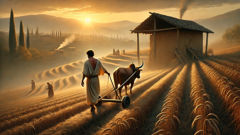Introduction
Long before the world took its familiar shape, before rivers carved their paths or forests shaded the earth, the Dahomey lands stretched beneath a boundless sky, waiting in silence. From this ancient hush, legend tells of a moment when all things began—a single, shimmering instant from which existence unfurled. At the heart of this beginning was Mawu-Lisa, the great creator, an inseparable duality embodying both the moon’s gentle wisdom and the sun’s radiant strength. For the Dahomey people, Mawu and Lisa were not merely deities, but the very essence of balance and possibility. Mawu, with her cool, nurturing presence, brought rest and reflection, while Lisa, blazing with energy, awakened growth and action. Together, their union wove the first threads of life and light.
In those early days, the world was nothing more than endless water and a vast, empty expanse. Yet within this emptiness, Mawu-Lisa stirred, her thoughts heavy with dreams of beauty and harmony. She floated between realms, her form flickering between silvery moonlight and golden daylight. With every breath, she shaped clouds and shadows, each a promise of what could be. It’s said that she danced in the heavens, and where her feet touched, stars blossomed like wildflowers, casting hope across the void.
But Mawu-Lisa knew that light alone was not enough. She longed to share her wisdom, her warmth, her infinite creativity. Drawing upon the fullness of her being, she resolved to divide herself: Mawu, the moon, would watch over the night, comforting all that slumbered; Lisa, the sun, would rule the day, inspiring all that awakened. This duality, this divine partnership, was the wellspring from which all life would flow.
As Mawu-Lisa began her work, her story became woven into the fabric of Dahomey life. Elders passed it to children beneath baobab trees, storytellers painted it with their voices in the smoky glow of firelight, and each sunrise and moonrise reminded the people of her ongoing gift. In this myth lies not only the origin of the world, but the heart of harmony—between light and darkness, rest and movement, woman and man, earth and sky. Thus begins the tale of Mawu-Lisa, and the birth of everything we know.
The Sundering: Mawu and Lisa Divide the Skies
When the world was still young, and only a great sea stretched beneath the vault of heaven, Mawu-Lisa gazed down upon the swirling mists. Her spirit filled every breeze, her essence woven into the light and shadow that danced across the waters. But as she drifted above this formless realm, she felt an ache—a yearning for diversity and purpose, for a world filled with movement, color, and meaning.

She closed her eyes and listened to the silence, then opened her heart to the whispers of possibility. With a will both gentle and unbreakable, she chose to become two: Mawu, mother of the night, serene and wise; Lisa, father of the day, bold and fiery. With this act, the sky trembled. A gentle breeze became a rushing wind, and the first divisions took form.
Mawu floated upward, her body shimmering with pale blues and soft purples. Her gaze soothed the restless tides, coaxing dreams from the shadows. Wherever her light touched, silver reflections danced on water and land alike. Lisa surged forth in a blaze of gold and orange, his laughter echoing across the world. His touch awakened the sleeping deeps, stirring them into motion. Between them, they brought the first dawn and first dusk, and from their interplay was born the day.
They did not act alone. To shape the world, Mawu-Lisa called upon their children—divine beings of land, sky, and spirit. Nana Buluku, the ancient mother, watched over them, offering her wisdom as they worked. The twins, Gbadu and Minona, learned the secrets of time and fate. The serpent Aido Hwedo coiled around the earth, supporting and shaping it as Mawu-Lisa molded continents from mud and dreams.
Lisa lifted great mountains from the sea, their peaks shining in the new sunlight. Mawu softened their edges with mist and rain, filling valleys with rivers and lakes. Lisa scattered seeds of flame, birthing volcanoes and deserts, while Mawu cloaked them in gentle night, allowing their fires to rest. The world took shape beneath their hands—balanced, alive, and utterly new.
Yet creation was not without its sorrows. As Lisa labored, his heat threatened to scorch the land. Mawu, seeing the danger, taught humanity to work together, to dig wells and plant shade trees. She crafted cool evenings to soothe the weary, and Lisa relented, allowing for rest and renewal. Their dance continued—sometimes harmonious, sometimes in tension—but always in pursuit of balance.
The people of Dahomey remembered these lessons. They honored Mawu in times of need and Lisa when energy was required. Farmers planted by the moon, harvested by the sun, and gave thanks to both. Each generation retold the story of the sundering, seeing in it a reflection of their own hopes and struggles. Through this myth, they understood the importance of unity and difference—the endless cycle of giving and receiving that sustains all life.
The Breath of Life: Mawu-Lisa Fashions Humanity and Nature
With the world taking form beneath the watchful eyes of Mawu and Lisa, creation pressed onward. The earth was sculpted, yes—but it was still silent, waiting for voices, for laughter, for purpose. Mawu descended first, her feet brushing the cool earth as she knelt beside a river’s bend. She scooped rich red clay from the bank, her fingers shaping the first figures with infinite care: arms curled around chests, heads bowed in humility, legs folded beneath bodies. One by one, she molded men and women in her own image—fragile, hopeful, brimming with the promise of life.

But clay alone could not awaken them. Calling on Lisa’s fire, Mawu lifted each figure toward the dawning sun. Lisa leaned down, blowing softly, his breath carrying the warmth of day. At once, the clay figures shivered, color flooding their cheeks as life blossomed within them. Eyes opened in wonder. Voices called out. Humanity rose to its feet, gazing at the sky with awe and gratitude.
Together, Mawu and Lisa gave each person a soul—a spark of their own essence. Mawu bestowed wisdom, compassion, and the ability to dream. Lisa granted energy, ambition, and the courage to act. The people were different in their gifts, yet all carried pieces of the divine within. Mawu taught them to listen to the night’s quiet lessons: how to rest, to heal, to reflect. Lisa urged them to greet each sunrise with hope, to work together and build their lives anew each day.
As the people spread across the land, Mawu-Lisa filled the world with life to keep them company. She shaped animals—lions for courage, crocodiles for patience, birds for freedom. She painted forests with every shade of green, scattered flowers to delight the eyes, and poured rivers so that water would always flow. Each creature was given a role: some would teach, some would serve as guides, others would simply bring joy.
But the world was not without hardship. There were seasons of hunger, when crops failed or rivers dried up. There were storms and fevers and times when fear crept into even the bravest hearts. In these moments, Mawu appeared in dreams, offering gentle counsel: "Endure, for all things change." Lisa sent rays of sunlight after rainstorms, promising renewal. The people learned to adapt—to pray, to hope, to celebrate life’s cycles.
Over generations, the Dahomey came to see all of nature as a living story—a conversation between earth and sky, animal and human, sun and moon. To them, every element was a sign of Mawu-Lisa’s love. They honored this sacred relationship with festivals at full moons, dances at sunrise, and quiet gratitude in every field and home. The myth of creation was not just a tale, but a living truth guiding their days.
Harmony and Wisdom: The Legacy of Mawu-Lisa in Dahomey
With creation complete, Mawu-Lisa withdrew to watch over the world from the heights of sky and the hush of night. Their work echoed in every heartbeat, every rustle of wind through baobab branches. The people of Dahomey flourished—planting, harvesting, building villages that pulsed with music and laughter. But they never forgot the lessons of their creators.

Harmony became the law of life. Families honored both Mawu and Lisa in all things—resting during the cool nights, toiling beneath the benevolent sun, always seeking balance between effort and peace. Elders told stories of Mawu’s patience and Lisa’s strength around communal fires. Children learned that wisdom and courage were not opposites but partners, each necessary for a full life.
The twin spirits of night and day revealed themselves in countless ways. When a child was born under a full moon, it was said Mawu’s touch would guide their dreams. When a harvest flourished under brilliant sunlight, people praised Lisa for his generous heart. During times of hardship—when drought or illness threatened—the Dahomey offered prayers to both deities, believing that neither darkness nor light alone could save them, but only their union.
The myth also shaped the Dahomey’s understanding of justice and responsibility. Mawu’s lessons taught compassion: to care for the vulnerable, to listen before acting. Lisa’s energy inspired progress: to work hard, defend the village, seek knowledge. Leaders were chosen for their ability to balance these gifts; a wise king or queen needed both vision and resolve.
As centuries passed, foreign winds swept across West Africa—traders arrived with new stories, invaders brought change. Yet through upheaval and transformation, the myth of Mawu-Lisa endured. It became a wellspring of resilience. During times of despair, the people looked to the sky and saw that even when the sun disappeared, the moon would rise. And after every night, dawn would return. The cycle gave hope and meaning to each generation.
In the modern age, the legacy of Mawu-Lisa still shapes Benin’s spirit. Festivals honor the dual deities with dances that mimic the rising and setting sun; artists paint their forms in bold color on village walls; elders whisper their wisdom to children at bedtime. The world continues to change, but the old lesson holds true: harmony is life’s deepest secret. In the balance of opposites—night and day, strength and gentleness, tradition and progress—there lies an unbroken thread connecting all who have ever called this land home.
Conclusion
The story of Mawu-Lisa endures far beyond its telling—woven through each sunrise and moonrise, each hope and sorrow that marks the passage of days. For the people of Dahomey and beyond, it is a living myth: a reminder that creation is not a single moment but a cycle of giving and receiving, rest and movement, unity and difference. In Mawu’s cool compassion and Lisa’s fiery energy lies a truth that speaks to every generation: that harmony is possible only when we honor every part of ourselves and our world.
In every field where farmers plant by moonlight and harvest beneath the sun, in every home where stories are shared at dusk, the legacy of Mawu-Lisa is alive. It is heard in lullabies and work songs, seen in art that celebrates both strength and tenderness, felt in every act of kindness and courage. As long as the sun rises and the moon glows, their dual presence offers hope—that from difference can come unity, from challenge can come renewal, and from the dance of opposites can come a world filled with meaning. The myth of Mawu-Lisa, like the cycle of day and night, endures without end.













